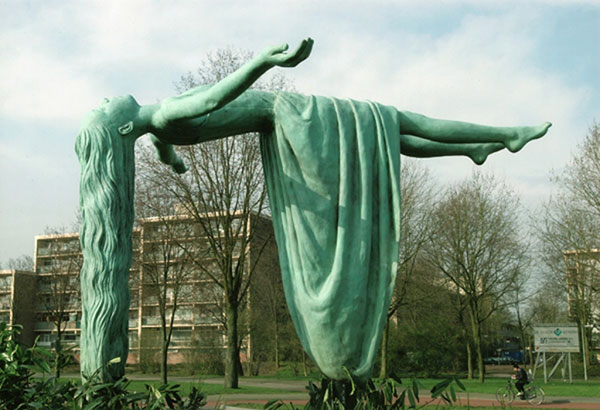‘Uplift’ collides with controversies midflight


Accusations of plagiarism were further boosted by Thom Puckey, the husband of Dutch artist Elisabet Stienstra who made “Virgins of Apeldoorn,” to which “Uplift” was allegedly copied, by saying, “Mr. Cacnio’s sculpture does not only imitate her idea in general terms, but also in specific terms.” (Photo from juxtapoz.com)
No work of art has generated more controversy since Mideo Cruz’s “Poleteismo” for the “Kulo” exhibition at the Cultural Center of the Philippines (which led to a blitz of media coverage, a Senate inquiry, and the premature closing of the show, among others) than Ferdie Cacnio’s “Uplift” — a public sculpture fronting the Main Theater of the University of the Philippines (UP), Diliman. While certain sectors of society may readily find offense with the juxtaposition of the image of Christ with pop and phallic symbols, what, one wonders, should get a rise out of people with a rendition of the female nude — a trope in the visual arts since classical antiquity — seeming to float above water, arms outstretched, her golden hair streaming behind her?
Quite a lot, it turns out.
One of the chief arguments of its detractors is that the work closely resembles a piece in the series of sculptures titled “Virgins of Apeldoorn” by the Dutch artist Elisabet Stienstra. Facing skyward and with arms outstretched, Cacnio’s and Stienstra’s sculptures both deliver the conceit of levitation, made possible by the structural support provided (or concealed) by their hair. There are significant differences. Stienstra’s work, aside by being balanced by her hair, is also supported by the drapery around her waist, which makes Cacnio’s work more structurally nimble by comparison. While seeming to have the same pose, Stienstra’s work appears to be perfectly symmetrical and flat on her back. Cacnio’s, on the other hand, features a higher degree of expressiveness as the torso seems to be drawn upwards, as her legs, with one slightly higher than the other, catching up with the rest of her.
The accusation of copying was further inflamed when Siestra’s husband, Thom Puckey, came out with a statement in Facebook saying that his wife “sees Mr. Cacnio’s sculpture as plagiarism. The principle of her work (made in 2001) is to use sculptural conventions to suggest weightlessness. Mr. Cacnio’s sculpture does not only imitate her idea in general terms, but also in specific terms: the long hanging hair, the falling-back head, the outstretched arms, the outstretched body. The similarities are too evident to be coincidental. Plagiarism is still plagiarism even if a few details have been altered.”
Cacnio denied the charge. “Before today, I had never seen nor heard of Ms. Stienstra or her work,” he retorted in a Facebook post. “Hindi ko siya kilala. We’ve never been to the Netherlands. I was not inspired by her, I did not model my work after hers. I am not guilty of plagiarizing or copying her work, ‘Virgins of Apeldoorn.’”
Those who rush to Cacnio’s defense point out that “sculptural conventions to suggest weightlessness” are not unique to Siestra, as it has also been done by other artists, such as the British sculptor Quentin Bell. For instance, his work, “‘Levitating Woman’ The Dreamer,” made in 1982 and located at the University of Leeds, features a female figure only supported by the wisp of cloth. “Innocence” by Andrew Davies appears to float, balanced only by the swirl of her hair. While not “levitating,” the female forms of Agnes Arellano that constituted “Project Pleiades” for this year’s Art Fair Philippines seemed to have taken off from the ground, with the black base of the sculptures merging with the dark of the gallery room.
A more incendiary issue seems to be how “Uplift” is routinely referred to as the female “Oble,” or “Oblation,” the defining sculpture of the UP System created by National Artist Guillermo Tolentino. UP students, alumni and faculty members were quick to react to the comparison. Jose Santos Ardivilla, a UP professor, in a Facebook post, contrasted Guillermo’s work with Cacnio’s. While the former “straddles a column of rocks symbolizing an ideal of overcoming centuries of colonial subjugation (and) is rising above and offering himself,” Ardivilla states that the latter “is elevated by her hair, which is a patriarchal dictation of woman’s beauty and her perceived worth…More glaringly she is supine...a position of subjugation. This is an offering, more like a display, without struggle.”
Nikki Luna, UP College of Fine Arts alumna and a Thirteen CCP Artists awardee, also in a Facebook post, stated that the “female Oble would have been stronger if she represented the plight of women who face reproductive and productive struggles (unpaid, paid work) especially the working class women. Women who constantly battle inequalities, discrimination, double standards, misogyny and a place in our country.”
It may have been marketing that went out of hand. “This is not the female Oblation,” mentioned Bianca Cacnio, the daughter of the artist, in a Facebook post in 2015 when the family was helping to raise funds for the sculpture by selling limited-edition tabletop versions. “It’s not the first, and definitely not the only female nude inspired by the Oble. The project is, at the moment, called the LADY OBLATION PROECT (sic) for ease of discussion and reference, but that is not what the sculpture itself will be called, from what I know.”
The sculpture, which was funded by the UP Class of 1985, would of course be called “Uplift” (or sometimes spelled as “UPlift,” to underscore its locale), which adds to a handful of public sculptures that dot the university. “Public” not only means that it is accessible to anyone who wants to see it, but that it is situated in an institution of the state subsidized by taxpayers’ money. “Uplift” can’t escape that context. Had it been located in a private land, such as the Bonifacio Global City in which Cacnio also has a sculpture called “Pasasalamat,” it would have raised nary a heckle. Hence, it’s not surprising that people, particularly direct stakeholders of UP Diliman, will readily voice their opinions, disapproving or otherwise, of the work.
Herein lies the sculpture’s most worrying fault: it is too open and too broad to different interpretations so that people, not least of whom is the artist himself who has expectedly assigned lofty ideals to his work (“Aspiring for Honor and Excellence,” as the plaque proclaims), can readily ascribe their own meaning to it and, because of the lack of signifying attributes, each meaning can hold. “Uplift” could suggest either subjugation or freedom, both spiritual transcendence or erotic passivity. The closed eyes could signify either rapture or orgasm. Its outstretched arms could imply either grace or powerlessness. The pool from which she ascends (which also provides a nifty technical solution so that the viewer can have proper distance in viewing the work) could have offered some basis as to who she is. Does she have roots in mythology, in literature? There’s nothing in its form or its title that conveys her unique particularities. “Uplift” is a blank slate — an open body — on which anyone can inscribe their opinion without feeling that they could be wrong.
In the absence of an allegorical basis, some people may be right to think that “Uplift” is decorative, which is not exactly a bad thing. There are far worse things in the world than a well-made object. When I dropped by one afternoon to see it for myself, people were taking selfies against it and evidently liking it despite, or possibly because of, the bad press that trailed in its wake. It was eye-catching, clear of form and intent, literal. It was, I must admit, mesmerizing. It was money well spent. No doubt better and more nuanced works (levitating or not, by a man or a woman) will be created after it, but it will be unlikely that another sculpture will generate the level of conversation and impassioned critique that “Uplift” has sparked, and for this reason alone Cacnio’s work may have inadvertently floated into the country’s history of art.



















